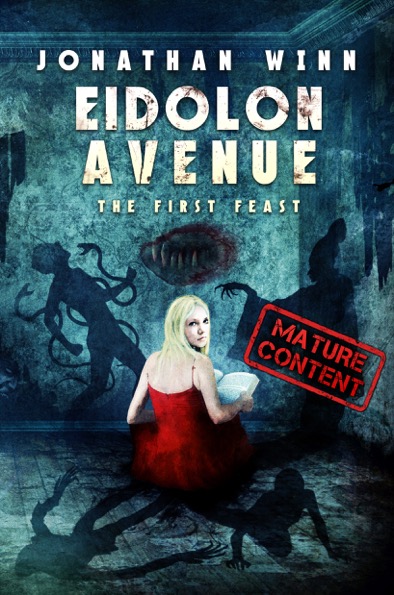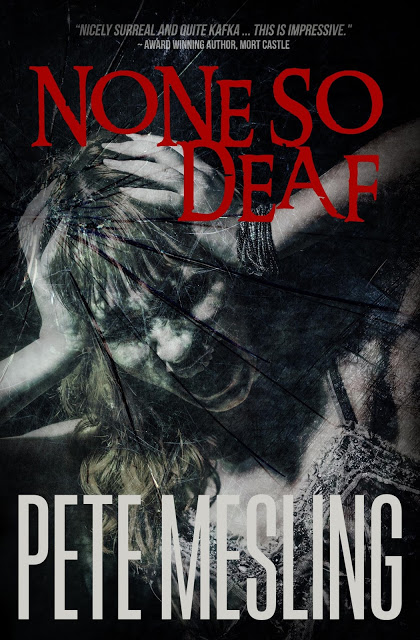Posted on Jan 19, 2016 by
Nick
This week on The Scariest Part, my guest is Jonathan Winn, whose new collection is Eidolon Avenue: The First Feast. Here’s the publisher’s description:
Eidolon Avenue: where the secretly guilty go to die.
One building. Five floors. Five doors per floor. Twenty-five nightmares feeding the hunger lurking between the bricks and waiting beneath the boards.
The First Feast. A retired Chinese assassin in apartment 1A fleeing from a lifetime of bloodshed. A tattooed man in 1B haunted by his most dangerous regret. A frat boy serial killer in 1C facing his past and an elderly married couple stumbling and wounded from fifty years of failed murder/suicide pacts in 1D. And, finally, a young girl in 1E whose quiet thoughts unleash unspeakable horror.
All thrown into their own private hell as every cruel choice, every deadly mistake, every drop of spilled blood is remembered, resurrected and relived to feed the ancient evil that lives on Eidolon Avenue.
And now, let’s hear what the scariest part was for Jonathan Winn:
Truth be told, I’ve had several “scariest parts” throughout my brief writing career. Chapter Forty-nine of my first book Martuk…the Holy was an experience that so unsettled me I needed to take a very long walk just to shake it off. And I still feel guilty over what fate did to sweet Tiber from Martuk…the Holy: Proseuche. Also, did I mention I darn near lost friends over the opening chapters of both “The Wounded King” and “The Elder”? Yep. Had to convince them to keep reading. Promise them the worst was over and the rest of the read was tame by comparison.
But Eidolon Avenue: The First Feast? My latest? Especially the third story, Apartment 1C, in this collection of five novellas and short stories? That was scary on a whole other level.
Let me explain.
Now, to be clear, Apartment 1C (aka “Click”) wasn’t scary because of what, exactly, was happening, although the events and their consequences are certainly horrific. “Click” was scary because…how can I put this? It was scary because why it was happening was coming from a mindset that could never be mine. The reasoning behind the cruelty, the quiet joy taken in it, the victim’s confusion shifting into realization and then terror, the whole thing turned my stomach. Put a lump in my throat. An insistent thump, thump, thumping in my head. Sent me to bed at night drowning in violent tsunamis of bitter guilt. I actually more than once — more than twice, to be honest — stopped midsentence, stood up and stepped outside just to get away from Apartment 1C. I just could not understand someone like Colton Carryage. And I could not comprehend how I, this nice boring guy — no, really, I am — was creating someone like Colton Carryage. But I was. And I had to. I needed to go there, go deep, put aside my inate kindness and somehow wrap my sane, level-headed logic and reason around this dangerous, vicious insanity because that’s what the narrative demanded.
Thankfully I had a publisher who was supportive — I think brave is the better word — no matter how dark things were. Of course, it also became clear that Eidolon was going to have the dubious distinction of being the first book they’d launch with a Warning Label. But, more importantly, I was fortunate to have my small handful of friends around to remind me that it was just a story and I just needed to get through it — the phrase “survive it” may have been used — so I could move on and leave it behind.
Yeah, that’s how freaked out I got.
So, if you want to know my Scariest Part, it was watching the horror of “Click” and Eidolon unfold, word by word, paragraph by paragraph, page by page. Watching my fingers clickety-clack a brutality which was and still is completely alien to me. It was knowing that readers may cringe and gasp and sob and throw the book across the room because of what Eidolon insisted on being. And then hate me, too!
Actually, now that I think about it, the Scariest Part when it comes to Eidolon is the fear that this is a story — and a collection — I’ll never live down.
Jonathan Winn: Website / Facebook / Twitter
Eidolon Avenue: The First Feast: Amazon / Barnes & Noble / IndieBound
In addition to Eidolon Avenue: The First Feast, Jonathan Winn (Member, HWA) is a screenwriter and author of the full-length novels Martuk…the Holy (A Highlight of the Year, 2012 Papyrus Independent Fiction Awards), Martuk…the Holy: Proseuche (Top Twenty Horror Novels of 2014, Preditors & Editors Readers Poll), Martuk…the Holy: Shayateen (2016) and The Martuk Series (“The Wounded King,” “The Elder,” “Red and Gold”), an ongoing collection of short fiction inspired by Martuk. His work can also be found in Horror 201: The Silver Scream, Writers on Writing, Vol. 2, and Crystal Lake’s Tales from the Lake, Vol. 2, with his award-winning short story “Forever Dark.”
 Batman: The Doom That Came To Gotham by Mike Mignola
Batman: The Doom That Came To Gotham by Mike Mignola



